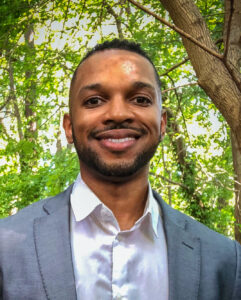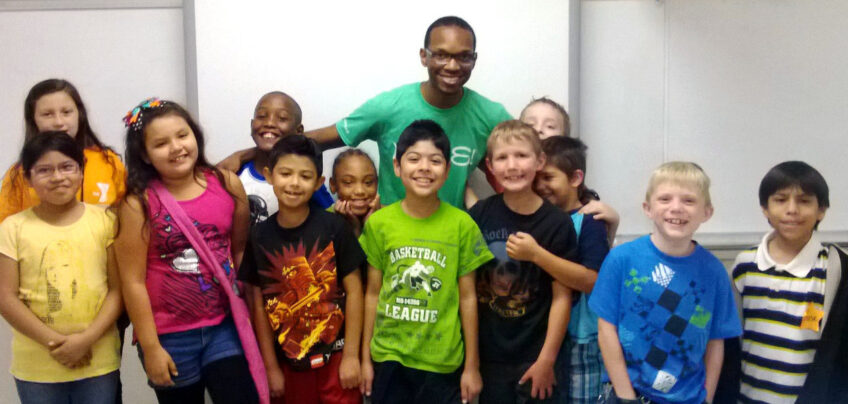“At the end of the day, it’s about our kids and their futures,” declared Jonathan Briggs, 34, the newly elected Prince George’s County School Board member for District 2, representing Greenbelt.
“It’s how we put kids first. How do we work in partnership with everyone in the community, for everyone? I understand what’s at stake when we don’t get it right. Kids deserve to receive education that prepares them for everything they desire to do.”
Briggs began his two-year term on December 5 and looks forward to tackling the budget starting with the December 8 meeting. “It was an election year, so it’s a little bit delayed,” he said. He’s also looking forward to “meeting and building relationships with principals and parents.”
Recent Greenbelter
Raised on the South Side of Chicago, Briggs settled in Greenbelt in 2018 to be close to Washington, D.C., and his barber and to have less of the hustle and bustle of the city. Briggs admits, “My life’s been so work-driven. A goal of mine is to get back into the arts, painting, drawing, film and video production.” An avid gym-goer, he practices strength training and hiking when possible. Aside from arts and fitness, Briggs enjoys Jamaican food and reading.
When asked about teachers who inspired him, he recalled Mr. Ali, a high school history teacher, who was “open” and “safe” for young folks to approach about their concerns, health and mental health. Briggs’ voice warmed as he remembered a Creative Arts teacher who offered him new experiences and “took me under her wing.”
Access for All
“I am a person who is rooted in social justice,” Briggs said. He described moving from a private primary school to a public high school on Chicago’s South Side as, “my first experience with education inequity.” He almost dropped out. “It was a hard situation,” he recalled. He subsequently transferred into a more functional school. Briggs says this eye-opening experience has framed the course of his life.
After college Briggs worked as a near-peer mentor through the federal City Year Program. The program addressed the dropout crisis by building relationships with students navigating real world challenges. Briggs experienced a system that “left kids by the wayside” and realized “something needs to be done about this,” leading him into Teach for America.
Connecting
After confronting the realities of the classroom, Briggs left teaching to address what he described as the “upstream issue,” saying, “What we need is people who sit in positions of power who understand what the issues are and understand the lived experiences of kids and teachers (and) administrators.” He worked for the governor’s office in Illinois and sought to influence educational policy in Congress.
Briggs currently works as a policy manager at America Forward, an organization that “unites social entrepreneurs with policy makers.” The group is the policy arm of New Profit, a venture philanthropy organization, bringing venture capital to invest in social causes while aiming for a financial return. He explains that his day job involves lobbying Congress and the administration on behalf of programs and organizations, including those that provide resources for schools and “creating pathways for kids” into careers in education. Briggs describes his work as creating connections and highlighting “really great programs” that are making a difference for students at a local level. He believes his job dovetails with and provides flexibility for “attending school board meetings, hearings, research and meeting with the stakeholders.”
Concerns of Families
Asked about his plans for his first 90 days, Briggs says he is assessing what is possible. He says he’s figuring out the stakeholders and issues involved in representing District 2. He mentioned parents, families, principals, other school board members and local politicians. Asked how he plans to communicate with his constituents, Briggs says he is leaning toward regular face-to-face meetings that would be recorded so those who cannot attend could watch.
Briggs said, “As a former educator I understand … instructional practices that need to be in place … research-based, evidence-based, that really move our students and our schools in the direction of closing the achievement gap that has been in existence for far too long. It’s also about understanding how schools work and where money comes from … to address specific things that schools are interested in.” Briggs hopes to support Prince George’s school leadership to tap into resources via philanthropy, the area he’s currently working in, as well as governmental funds to address “all of the challenges our school system is facing – inequity, mental health crisis, teacher shortages, the academic achievement gaps.”
School Boundaries
Briggs is honest that he has more to learn about the specific needs of families in District 2. When asked about the possible impacts of changing school boundaries on Greenbelt Middle School, and about the fears of local parents that moving students to different schools to avoid overcrowding will reduce funding and lead to higher student-teacher ratios, Briggs replied, “It would, obviously, impact boundaries and what’s your local community school … but I don’t think that’s going to change the volume of students. As far as the teacher shortage challenge is concerned, I don’t think that’s necessarily going to impact.”
He also mentioned possibilities of classroom trailers and the need for school board members to work together to support families who live in one district while their students attend school in another. Briggs stressed that he plans to meet with local politicians and parents to learn more.


